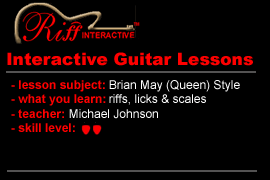Scroll through the lesson and click on notation/video/audio links to load the interactive players.
Please subscribe to get full access to all lessons for only $7.95/month PLUS 1 week free trial.

Riff Interactive lessons are
LESS expensive and
MORE interactive than alternatives!
More Info
|
|

Teacher: Hello class. This is our 4th lesson on
the style of Brian May of Queen covering more of the Night At The Opera/Day At
The Races era. In this lesson you will learn more about layering guitar parts
and how to use scales as a melody. You'll also learn techniques that will
also help you apply scales over chords as well. Many of these licks and scales
are easy, but will help develop your understanding of Brian's sound. The lesson
sample covers many of the licks you will learn.
Lesson
Sample
Teacher:
OK, let's get started. Our first riff is a chromatic type run starting in
E
Part 1 - Riff
1
Part 1 - Riff
1
Teacher: Notice that
you have a descending chromatic run, the run later skips the note and then you
jump up to F# using the same riff. Here's the jam track:
Looping Jam
Track 1
Teacher:
You might want to practice slowly a few times to get the riff down. Regular
speed will take more practice for your to get down clean. Now let's go to part 2
of the riff.
Part 1 - Riff 2
Part 1 - Riff 2
Teacher:
You start in B with this section. It's basically barre chords until you use
a descending run in the B minor pentatonic and then ending on the Maj
3rd of B and then back to the octave B. Also notice the descending bass
note (G#) and then jumping to F#, this type of line is common in classical
music. Now let's move on to part 2, the rhythm chords are B, G, F#,
E
Part 2 - Riff
1
Teacher: Now what we are going to do is play
scales over each of these chords. Here's the jam track:
Looping Jam
Track 2a
Teacher:
Next we will play each scale over the chords in the jam track. Our first scale
is B Major:
Part 2 -
Scale 1 - B Major
Teacher:
Now it will get a little tricky to play different scales over each chord. Our next
scale is G Major:
Part 2 - Scale 2 - G Major
Teacher:
Now you play the F# Mixolydian:
Part 2 - Scale 3 - F # Mixolydian
Teacher:
And then finally descend using the E Major scale:
Part 2 -
Scale 4 - E Major
Teacher:
OK, now comes the challenging part, try playing all the scales over each chord
of the jam track.
Part 2 - Riff 2
Part 2 - Riff
2
Teacher:
OK, this is an excellent exercise for you to practice! In fact I played
this part over and over because it was fun to play. Here's the jam track, the
real challenge is keeping up the speed of the scale with the timing of the
chords.
Looping Jam Track
3
Teacher:
Practice this for awhile. OK, let's move on, now we will change riffs. This
first riff is the rhythm/bass guitar line, it's a simple classical type
phrase.
Part 3 -
Riff 1
Part 3 - Riff
1
Teacher:
See it's very simple, now we will layer another guitar melody that creates a
trumpet type line. Brian May would often imitate a cello, violin,
trumpet,...
Part 3 -
Riff 2
Part 3 - Riff
2
Teacher:
These are basic arpeggios, the first arpeggio is E Major, then F# Min arpeggio,
then G# Min arpeggio. Here's the first and second riffs together in a jam
track, practice both parts.
Looping Jam Track 4
Teacher:
The last file was bad try this one, OK, let's try other exercises, the next few
riff are common trumpet type melodies you can play on guitar. I'm sure
you've heard these before.
Part 3 - Riff 3
Part 3 - Riff
3
Teacher:
Recognize it?
fish: charge?
Teacher: Yep! Here's another one you can
try.
Part 3 - Riff
4
Part 3 - Riff
4
Teacher:
The trick in this melody is the picking, you basically barre three string (2nd,
3rd, 4th) and pick away! Here's another trumpet melody you can
try:
Part 3 - Riff
5
Teacher:
Yes, they're all pretty easy, but a cool exercise as well. You can always
entertain your friends and family with these <grin>. I'm sure you
recognized the last one as well.
fish: taps?
Teacher: Yep! Well that's it for the lesson, I
hope to see you next week! Bye!
fish: thanks teacher
|
<< load notation from left
|
|
<< load audio from left
|
<< load audio from left
|